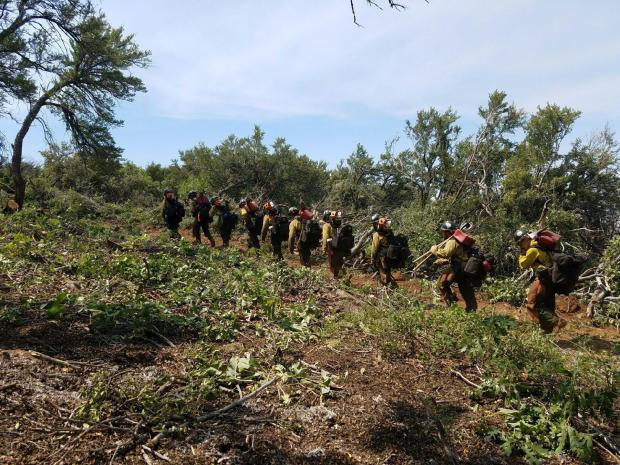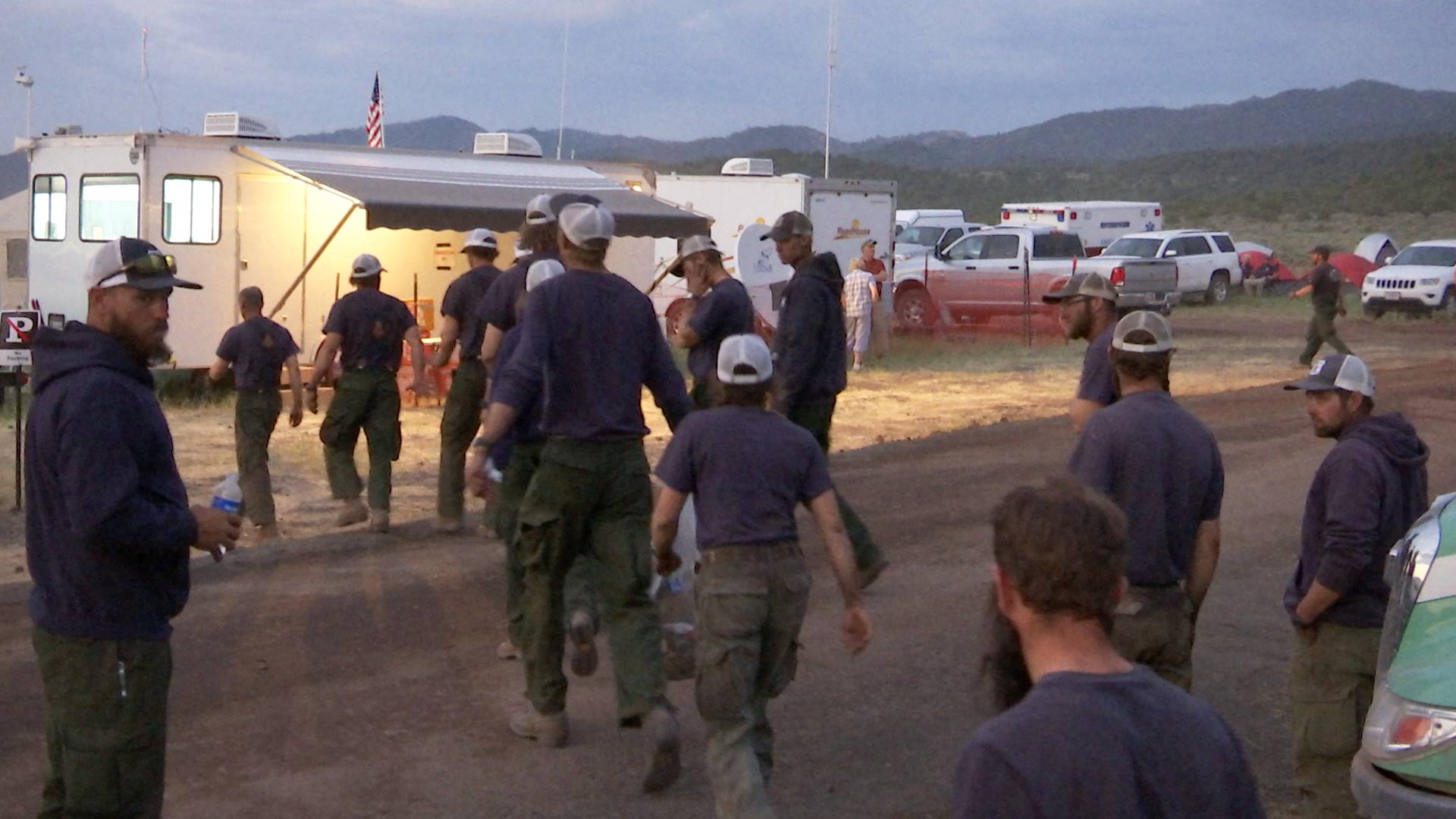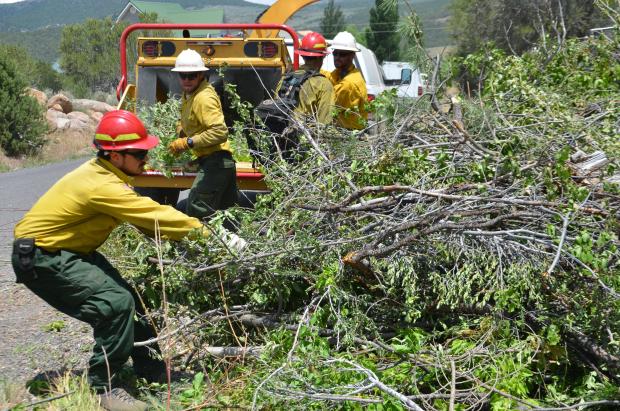ST. GEORGE — When a wildfire burns near a town, a large-scale tent city is constructed nearby. While Rome may not have been built in a day, the wildland fire base camp for crews battling the Pine Valley Saddle Fire practically was.

A team of 731 firefighters and support personnel from across several states has descended on Pine Valley Mountain to battle what has grown to a 1,540-acre blaze raging in Washington County.
On June 13, flames from a lightning strike on Saddle Mountain vigorously spread, and Grass Valley – an area to the north of the fire – was quickly transformed into a fire base camp for the federal emergency response teams mobilized to fight the inferno.
St. George News was given a look behind the scenes this week at the Saddle Fire base camp and the sheer magnitude of effort needed to support the fire crews assigned to the area.

Fire camps are deployed rapidly and efficiently, constantly changing in size as the fire does. These temporary “cities” house some of the most elite men and women among wildland firefighters.
Within 24 hours of receiving the call, fire crews say goodbye to their friends, families and homes and say hello to their new home. For the majority, it is a small tent in the wilderness along the edges of base camp, with the elite closer to the fire edge; in the case of the Saddle Fire, these are strategically placed along the mountain ridge.
Most of the wildland firefighters work 16-hour shifts for 14 days. During these two weeks, firefighters don’t get a day off, and their stay may be extended to 21 days at most, said Larry Helmerick, public information officer with the National Incident Management Operation.
While a wildfire may never rest, fire personnel need sleep, food and sometimes medical attention. All of these amenities – and more – can be found in the fire base camp.
The heart of the base camp is dominated by large catering trailers serving as a kitchen with a dining area flanked by hand-washing stations. Multiple semitrailers are used to serve more than 220,000 meals per day to keep up with the requirement that firefighters eat 6,000 calories a day, Helmerick said.

A couple hundred feet away, another trailer houses the camp’s shower facility. To the west, a supply yard provides firefighters with everything they need for the day, from their fire resistant clothing to flagging tape and batteries that power their radios.
Nearby, paramedics are on hand in a fully-equipped medical tent. As of Thursday, fire officials said there have only been two recorded minor heat-related injuries on the Saddle Fire.
While most shifts are 16 hours, Helmerick said they are fighting the Saddle Fire 24 hours a day, seven days a week.
As night shifts increased on the Saddle Fire, sleeper units were brought in to meet the challenge of day sleeping. The climate-controlled units create an artificial night environment that allows firefighters to get proper rest. With sleeping bunks three rows high, each unit sleeps up to 42 firefighters.
The Hotshots and fire crews
Five helicopters, 36 engines, one bulldozer, four water tenders and one air attack have been assigned to the Saddle Fire. But no amount of equipment can replace what the Hotshots do.

Nine Type I interagency Hotshot crews – each consisting of 20 firefighters – have been assigned to the Saddle Fire suppression effort.
Hotshots are to firefighting what Special Forces are to the military, Helmerick said. Their training is intense, their assignments are extreme and their members are considered the most elite wildland firefighters in the world.
They often respond to large high-priority fires and are trained and equipped to work in remote areas for extended periods of time with little logistical support. These elite firefighters are up against erratic winds, extreme heat and fast-moving flames.
Black Mountain Hotshots Superintendent Jed Rudelbach said his crew was able to get up on the fire’s edge Monday and go direct on the fire.

“The weather conditions permitted us to get up there and cut off a piece that was going down towards Pine Valley,” Rudelbach said, “so that was a good day.”
Rudelbach runs a 20-person crew, and overseeing their safety is one of his top priorities.
“Hotshot superintendents are fierce when it comes to their crew,” Helmerick said. “He’s like a mother hen or a father protector because they’re all younger. They’ve got to be tough. I mean they have strenuous work – they really, really do.”
Bulldozers and firetrucks aren’t able to follow Hotshots into the remote wilderness. So these elite firefighters learn to use smaller equipment, such as chainsaws and shovels, to combat wildfires instead.

In addition to the Hotshots, 12 Type II handcrews –consisting of 18-20 firefighters – have also been assigned to Saddle Fire detail. These men and women serve as the infantry of wildland fire forces.
Working side by side, the crews’ main responsibilities are to construct a fire line – a strip of land cleared down to the soil of flammable materials – around wildfires to control the fire, burn out fire areas and mop up after the fire.
As day firefighters come in, the night crews go out, and the base camp cycle starts anew. However, once the camp is taken down, visitors to the area won’t even know it existed.
“When we leave, you’ll never know we’re here because we rehab this whole area,” Helmerick said. “You’ll come back two-three weeks later and you’ll never know there were 731 firefighters here.”
Click on photo to enlarge it, then use your left-right arrow keys to cycle through the gallery.

Fire crews are fed well at the Saddle Fire base camp located in Grass Valley on the Dixie National Forest near Pine Valley, Washington County, Utah, June 27, 2016 | Photo by Michael Durrant, St. George News

Firefighters line up for dinner at the Saddle Fire base camp located in Grass Valley on the Dixie National Forest near Pine Valley, Washington County, Utah, June 27, 2016 | File photo by Michael Durrant, St. George News

View from the air of the Saddle Fire base camp located in Grass Valley on the Dixie National Forest near Pine Valley, Washington County, Utah, June 27, 2016 | Photo courtesy of NIMO, St. George News

The Saddle Fire base camp continued to grow throughout the week, Grass Valley on the Dixie National Forest near Pine Valley, Washington County, Utah, June 25, 2016 | Photo courtesy of NIMO, St. George News

A generator and a dedicated fuel truck power the Saddle Fire base camp at Grass Valley on the Dixie National Forest near Pine Valley, Washington County, Utah, June 25, 2016 | Photo courtesy of NIMO, St. George News

A view of the wildfire from the Saddle Fire base camp at Grass Valley on the Dixie National Forest near Pine Valley, Washington County, Utah, June 28, 2016 | Photo courtesy of NIMO, St. George News

The Saddle Fire continued to burn toward Forsyth Canyon Tuesday above Pine Valley, Washington County, Utah, June 28, 2016 | Photo courtesy of NIMO, St. George News

Snake River Hotshots worked on building line Wednesday on the Saddle Fire above Pine Valley on the Dixie National Forest, Washington County, Utah, June 29, 2016 | Photo courtesy of NIMO, St. George News

Alta Hotshots working on the Saddle Fire above Pine Valley on the Dixie National Forest, Washington County, Utah, June 24, 2016 | Photo courtesy of Alta Hotshots, St. George News

Wildland urban interface facing firefighters on Saddle Fire in Pine Valley, looking up Lloyd Canyon, Washington County, Utah, June 26, 2016 | Photo courtesy of NIMO, St. George News

Firefighters removing fuel to create a fire break along Mahogany Bench Road, Washington County, Utah, June 24, 2016 | Photo courtesy of NIMO, St. George News

Operations giving briefing on Saddle Fire at base camp in Grass Valley, Washington County, Utah, June 23, 2016 | Photo courtesy of NIMO, St. George News

Dinner line at Saddle Fire base camp stretches as far as you can see, Washington County, Utah, June 24, 2016 | Photo courtesy of NIMO, St. George News

"Dinner on the Saddle Fire rocked!" fire officials said. Smoked brisket with fan tail shrimp and "all the fixins, Washington County, Utah, June 24, 2016 | Photo courtesy of NIMO, St. George News

The Lake, a national fire caterer, carving fresh brisket as firefighters pass through the dinner line at the Saddle Fire base camp, Washington County, Utah, June 24, 2016 | Photo courtesy of NIMO, St. George News

Prime rib dinner served at the Saddle Fire base camp, Washington County, Utah, June 27, 2016 | Photo courtesy of NIMO, St. George News

Brisket going in the smoker to feed the hard working firefighters on the Saddle Fire in Pine Valley, Washington County, Utah, June 24, 2016 | Photo courtesy of NIMO, St. George News

NIMO Portland LSC1 getting turkey, dressing and gravy dinner served at the Saddle Fire base camp, Washington County, Utah, June 23, 2016 | Photo courtesy of NIMO, St. George News

As nightshifts increased on the Saddle Fire, sleeper units were brought in to meet the challenge of day sleeping. With sleeping bunks three rows high, each unit sleeps up to 42 firefighters, Washington County, Utah, June 25, 2016 | Photo courtesy of NIMO, St. George News

Cedar City Hotshots working hard on the Saddle Fire in Pine Valley, Washington County, Utah, June 26, 2016 | Photo courtesy of NIMO, St. George News

Black Mountain Hotshots coming into base camp for a well deserved dinner after working the Saddle Fire, Washington County, Utah, June 27, 2016 | Photo courtesy of NIMO, St. George News

Members of the Pine Valley community show appreciation for the support of fire crews assigned to the Saddle Fire on the Dixie National Forest near Pine Valley, Washington County, Utah

Fire crew clearing woody debris near the Saddle Fire on the Dixie National Forest, Washington County, Utah, June 30, 2016 | Photo courtesy of InciWeb, St. George News

Fire crew clearing woody debris near the Saddle Fire on the Dixie National Forest, Washington County, Utah, June 30, 2016 | Photo courtesy of InciWeb, St. George News

Fire crews head to the Saddle Fire fireline on the Dixie National Forest, Washington County, Utah, June 30, 2016 | Photo courtesy of InciWeb, St. George News

A semitrailer full of drinks helps to keep firefighters hydrated at the Saddle Fire base camp at Grass Valley on the Dixie National Forest near Pine Valley, Washington County, Utah, June 29, 2016 | Photo courtesy of InciWeb, St. George News

Masticator removing fuel along the Saddle Fire fireline, Washington County, Utah, June 29, 2016 | Photo courtesy of InciWeb, St. George News

Medical unit at Saddle Fire base camp at Grass Valley on the Dixie National Forest near Pine Valley, Washington County, Utah, June 29, 2016 | Photo courtesy of InciWeb, St. George News

A temporary gas station set up at the Saddle Fire base camp at Grass Valley on the Dixie National Forest near Pine Valley, Washington County, Utah, June 27, 2016 | Photo by Kimberly Scott, St. George News

The lightning-caused Saddle Fire burns on the Dixie National Forest near Pine Valley, Washington County, Utah, June 27, 2016 | Photo by Kimberly Scott, St. George News

Fire crew clearing woody debris near the Saddle Fire on the Dixie National Forest, Washington County, Utah, June 29, 2016 | Photo courtesy of InciWeb, St. George News

Members of the Pine Valley community show appreciation for the support of fire crews assigned to the Saddle Fire on the Dixie National Forest near Pine Valley, Washington County, Utah

A Thursday night thunderstorm at the Saddle Fire base camp got tents wet. Cattle quickly moved in Friday morning to lick the tents, Washington County, Utah, July 1, 2016 | Photo courtesy of NIMO, St. George News
Email: [email protected]
Twitter: @STGnews
Copyright St. George News, SaintGeorgeUtah.com LLC, 2016, all rights reserved.


Excellent written and photo details of this undertaking .
Even those of us living close by had no real idea of what all was involved .
Clearly this event is way larger than any local emergency response team could have kept up with .
Please extend our gratitude to the teams .
And again , Thank-you for the great report !